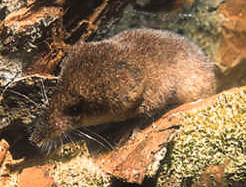Facts About Alpine shrew
The alpine shrew is a small mammal from the Soricidae family, commonly found in the alpine meadows and coniferous forests of Southern Europe's mountain ranges, including the Alps, Pyrenees, Carpathians, and Balkans. It is distinguished by its diminutive size, dark fur, reddish-brown teeth, long pointed snout, and rounded pink ears. Although it shares its habitat with other shrew species, you can identify the alpine shrew by its darker fur and longer tail.
This small creature inhabits Central and Eastern Europe, in countries such as France, Germany, Poland, Slovakia, and those of the former Yugoslavia. It prefers elevations between 200 and 2,500 meters, often choosing damp pastures, coniferous woodlands, and rocky areas near mountain huts. The alpine shrew is nocturnal and an adept climber, using scent glands to mark its territory. Its diet mainly comprises insects, spiders, snails, and earthworms. Nevertheless, it also becomes prey to predators such as foxes, weasels, domestic cats, and tawny owls.
Unfortunately, the alpine shrew is listed as "Near Threatened" on the IUCN Red List. Its population is gradually declining, primarily due to habitat destruction from hydro-electric projects and tourism. It has already disappeared from some regions, like the Pyrenees and the Harz Mountains in Germany, raising concerns about its future in these areas.

 Liechtenstein
Liechtenstein